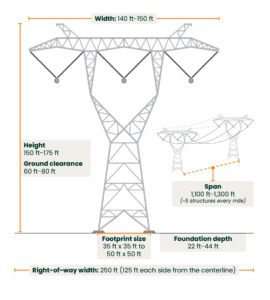|
|

This map shows the substations that a new 765 kilovolt transmission line would connect to. No specific route has been proposed, but the line could run through Pipestone County. Source: PowerOn Midwest
An open house regarding the proposed PowerOn Midwest transmission line project is planned for Tuesday, Nov. 4 from 10 a.m. to noon at the Hiawatha Lodge in Pipestone.
“PowerOn Midwest is a series of new electric transmission projects enhanced by a 765-kilovolt (kV) transmission backbone that is being developed by Great River Energy, ITC Midwest, Otter Tail Power Company and Xcel Energy,” said Anna Thill, community relations manager for Xcel, during the Oct. 14 Pipestone County Commissioner meeting. “Overall, the project will connect eastern South Dakota, southern Minnesota and the broader region, enhancing grid reliability in the upper Midwest to meet the growing and evolving energy needs.”
According to information presented by Xcel representatives at the meeting, the project would run from the Big Stone South substation in northeast South Dakota to a substation in Brookings to the Lakefield junction substation to a substation in Pleasant Valley to the north Rochester substation to the Hampton substation in the metro area. The transmission line could potentially run through Pipestone County on its way from the Brookings substation to the Lakefield junction substation.
“Somehow we have to get into Minnesota and it looks like we will somewhere in Pipestone most likely have a new 765 line,” said Tim Rogers, manager of siting and permitting with Xcel.

This is what the support structures for a new 765 kilovolt transmission line could look like. The line, which could run through Pipestone County, would increase the electricity transmission capacity in the region. Source: PowerOn Midwest
Thill said electricity use is growing due to new and expanding manufacturing, “the electrification of all things,” and emerging technologies such as data centers and artificial intelligence applications. She said demand is expected to significantly increase over the next couple decades and the current transmission system does not have the capacity to meet the increased demand. That combined with the changing ways electricity is generated — with a focus more on wind, solar, natural gas and other emerging technologies — is creating a need for a long-term solution, Thill said.
Commissioner Luke Johnson asked if existing solar and wind projects in the area would be able to utilize the transmission line, so they didn’t have to be turned off periodically due to limited transmission capacity. Thill said she thought the project was meant to capture that energy production, so those projects didn’t have to power down, and also to provide the capacity to add more.
The line will be supported by steel, lattice structures that will be around 150 to 175 feet high and 140 to 150 feet wide at the top, according to information presented at the meeting. The span between the structures will be around 1,100 to 1,300 feet apart. Jeremy Glick, the project manager, said the line would be owned by Xcel Energy and ITC, a transmission company out of Michigan.
The project requires a certificate of need and route permit from the Minnesota Public Utilities Commission. Rogers said there will be open houses, public hearings and public information meetings throughout the process.
“We’ll be out here about four times with these projects,” he said.
The process is expected to take several years. A preliminary schedule shows that a certificate of need application is expected to be submitted in February, a route permit application is expected to be submitted in late 2026, and the PUC is expected to make a decision on the certificate of need in 2027 and the route permit in 2028. Construction is expected between 2030 and 2034 and energization of the transmission line is expected between 2032 and 2034.
Commissioner Dan Wildermuth and Commissioner Dallas Roskamp are members of the Rural Minnesota Energy Board, which provides policy guidance on issues surrounding energy development in rural Minnesota, and Wildermuth said the organization was supportive of the transmission line project.
“This is something we’ve advocated for for years because this is our product,” he said.


